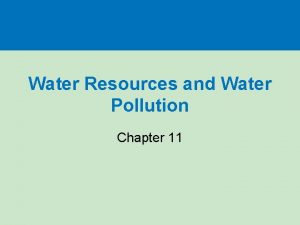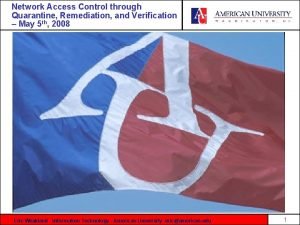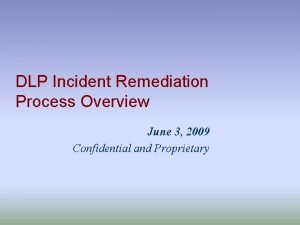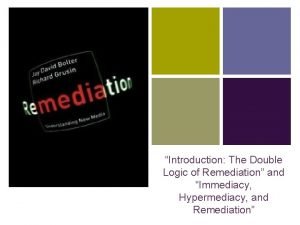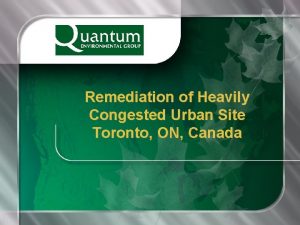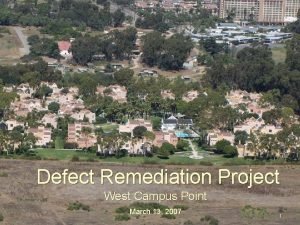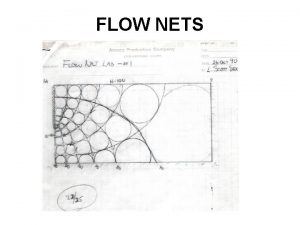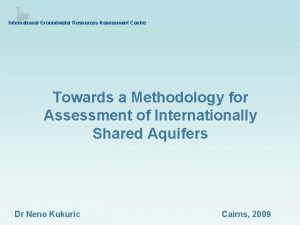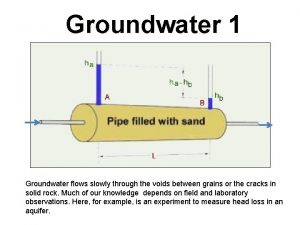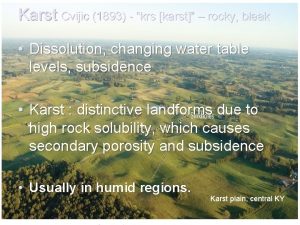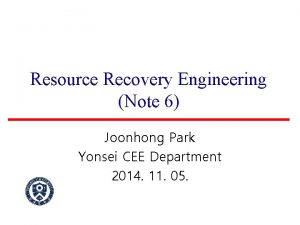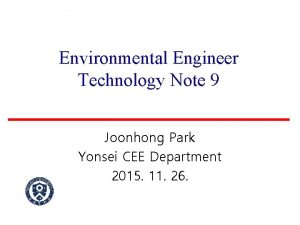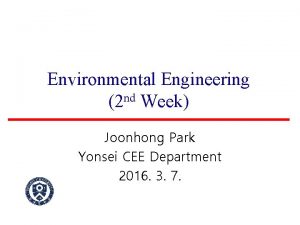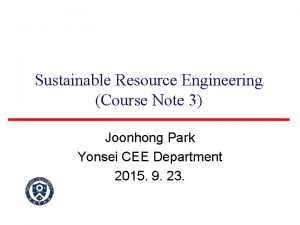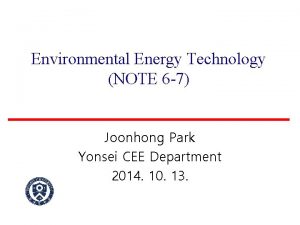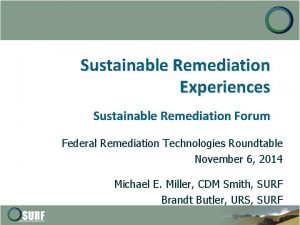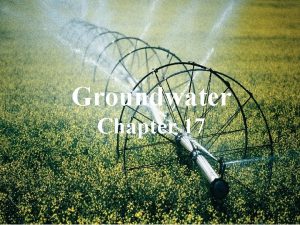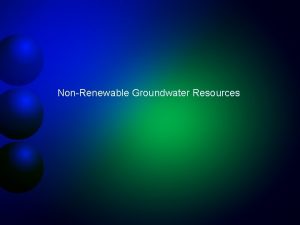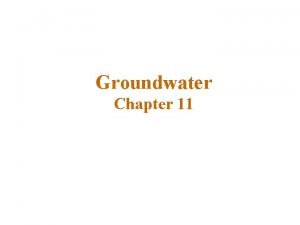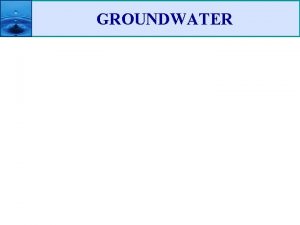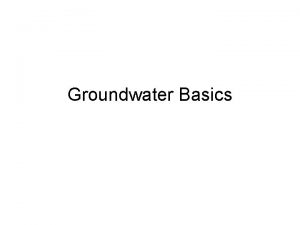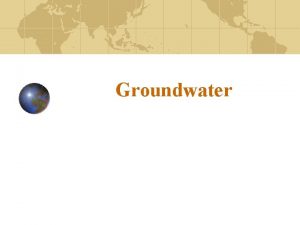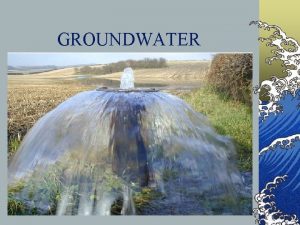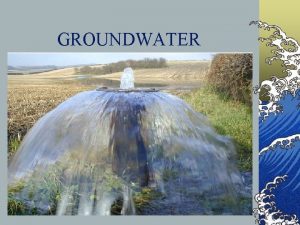Groundwater Pollution Remediation NOTE 3 Joonhong Park Yonsei





























- Slides: 29

Groundwater Pollution Remediation (NOTE 3) Joonhong Park Yonsei CEE Department 2015. 10. 12. CEE 3330 Y 2013 WEEK 3

Storage Coefficient, S • Definition: the volume of water released from storage (ΔVw) per unit decline in piezometric head (ΔФ) per unit area (A) of the aquifer HERE: Ss (Specific Storage), Sy (Specific Yield), B(thickness of aquifer) • 0<S<Effective Porosity, neff

Specific Storage, Ss (Freeze and Cherry, 1979) Definition: the volume of water that an aquifer releases from storage, per volume, per unit decline in piezometric head Here △p (decline in pressure), γw (specific weight of water) Here βp (compressibility of aquifer material) βw (compressibility of water)

Specific Yield (unconfined aquifer) Sy Volume of water drained per unit are per unit decline in piezometric head (water table) Sy + Sr = n (Sy < n) Here: Sr is specific retention n is porosity Sy: 0. 1~0. 3 (ex. Clay 0. 02, Sandy clay 0. 07, Silt 0. 18 Fine sand 0. 21, Coarse sand 0. 27, Dune sand 0. 38 Peat 0. 44)

Storage Coefficients (S) in Typical Aquifers • Confined Aquifer: • Unconfined Aquifer:

Dupuit Approximation • Flow is essentially horizontal or may be treated as such • Assumption fails in regions where flow has a large vertical component • Good approximation if aquifer thickness varies only gradually • Applicable to leaky aquifer if leaking is not so large

Transmissivity • Rate of flow per unit width through entire aquifer thickness per unit piezometric head gradient

Two-Dimensional GW Flow Equations Assume horizontal flow (Dupuit approximation) => vertical equipotentials Confined Aquifer Unconfined Aquifer N: recharge rate

Flow to a well in a confined Q aquifer Assumptions: Ф(r) qzt r qzb

After the assumptions are considered, the equations can be simplified as the following equation.

Boundary conditions? At r=rw At r=L

Incorporating BCs

Thiem Equation (1906) Here σ = Фo – Ф (draw down) RADIUS OF INFLUENCE: distance beyond which drawdown is negligible.

Steady flow to a well in an unconfined aquifer Q Ф(r) r Assumptions:

Boundary conditions?

Dupuit-Forchheimer Well Discharge equation. Confined-Unconfined Comparison

Unsteady state confined aquifer GW solution When u is smaller than 0. 01, then, In which conditions is the u small? Radius of Influence (u < 0. 01)

Theis Solution

Papadopulos Solution (Extensions to anisotropic media)

Cooper-Jacob Solution (For a small u) When u is smaller than 0. 01, then, In which conditions is the u small? Radius of Influence (u < 0. 01)

Unsteady flow to a well (unconfined aquifer) Corrected drawdown

Principle of Superposition • If Φ 1 = Φ 1 (x, y, z, t) and Φ 2 = Φ 2 (x, y, z, t) are two general solutions of a homogenous linear partial differential equation L(Φ) = 0, then any linear combination Φ = C 1 Φ 1 + C 1 Φ 2 where C 1, C 2 are constants is also a solution of L(Φ) = 0. • Applications: multiple well systems, non -steady pumpage, boundary problems

Image Well Theory (1) Barrier Boundary d Q Pumping Well x d. A/d. X = 0 (no flux B. C. ) at X =0

No barrier aquifer Q X r

Image Well Theory (1) Barrier Boundary: How to compute drawdown at the observation well? Q d Image Well Q d r 2 Pumping Well r 1 Observation Well x d. A/d. X = 0 (no flux B. C. ) at X =0

Image Well Theory (2) Recharge Boundary d Fully penetrating stream Constant head at X =0 Q Pumping Well x

Image Well Theory (2) Recharge Boundary: Find drawdown at the observation well. Q d Image Well Q d r 2 Pumping Well r 1 Observation Well Fully penetrating stream Constant head at X =0 x

Image Well Theory (3) Between Barrier Boundaries Q Pumping Well

Image Well Theory (4) Barrier-Recharge Boundaries Q Pumping Well Fully penetrating stream
 Source of contamination
Source of contamination How to decrease water pollution
How to decrease water pollution Blake kozeny
Blake kozeny Yonsei university college of nursing
Yonsei university college of nursing Yonsei university computer science
Yonsei university computer science Debit note format
Debit note format Difference between note making and note taking
Difference between note making and note taking Note taking and note making
Note taking and note making Goods received note
Goods received note Simple discount rate formula
Simple discount rate formula Difference between note making and note taking
Difference between note making and note taking Debit note meaning
Debit note meaning Example of signal word
Example of signal word Nevada eits
Nevada eits Ckla assessment and remediation guide
Ckla assessment and remediation guide Nac remediation
Nac remediation Dlp incident management process
Dlp incident management process Remediation plan in change lifecycle
Remediation plan in change lifecycle Remediation of the struggling medical learner
Remediation of the struggling medical learner Double logic of remediation
Double logic of remediation Site remediation toronto
Site remediation toronto Defect remediation
Defect remediation Mold damage somerset
Mold damage somerset Sox testing automation
Sox testing automation Brush mountain park
Brush mountain park Groundwater flow net
Groundwater flow net Groundwater assessment methodology
Groundwater assessment methodology Groundwater information network
Groundwater information network Darcy law
Darcy law Karst topography
Karst topography

